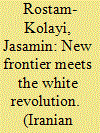|
|
|
Sort Order |
|
|
|
Items / Page
|
|
|
|
|
|
|
| Srl | Item |
| 1 |
ID:
082019


|
|
|
|
|
| Publication |
2008.
|
| Summary/Abstract |
This article examines the American Presbyterian education project in Iran from the early nineteenth century to 1940. While most literature on the subject concerns Iranian state-missionary relations and Presbyterian boys' schools in Iran, this article seeks to address the interactions between American Presbyterians, the Iranian state, and students and families of Iranian girls' schools. A study of the Presbyterians' flagship girls' school in Iran Bethel/Nurbakhsh and its sixty-six-year history reveals missionary intentions, tactics, and accomplishments, as well as the adaptations and accommodations pressed upon them by the Iranians they served. Despite the school's promotion of modern American norms and Christian teachings, the young graduates of Iran Bethel/Nurbakhsh developed a strong sense of loyalty to both Iran and Islam, thus turning an evangelist mission into an important feature of the construction of Iranian nationalism and modernity
|
|
|
|
|
|
|
|
|
|
|
|
|
|
|
|
| 2 |
ID:
160287


|
|
|
|
|
| Summary/Abstract |
The Peace Corps brought an estimated 1,800 Americans to Iran from 1962 to 1976, coinciding with the unfolding of Mohammad-Reza Shah Pahlavi’s Enqelāb-e Sefid, or White Revolution. This article surveys Peace Corps Iran’s fourteen-year history by dividing it into three distinct moments defined by changing social and political conditions in Iran and shifting US‒Iranian relations. Initially, the Peace Corps Iran experiment built on earlier American foreign assistance programs, while coinciding with the roll-out of the White Revolution. Second, during its heyday in the mid-1960s, the Peace Corps inevitably became entangled with the White Revolution’s unfolding, both experiencing a phase of expansion and apparent success. Finally, as Iranian social and political conditions moved toward instability by the 1970s, Peace Corps Iran also seemed to have lost its direction and purpose, which ultimately led to a vote by volunteers to terminate the program. Based on accounts by US Peace Corps volunteers and the Iranians with whom they worked, the Peace Corps Agency, and the US State Department, this article argues that, ultimately, the Peace Corps Iran experience left a more lasting legacy on individuals than institutions.
|
|
|
|
|
|
|
|
|
|
|
|
|
|
|
|
|
|
|
|
|